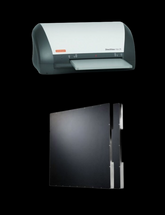Posted by Oranotech on 3rd Oct 2025
DR Vs CR Medical Imaging
The main difference is that DR uses a direct flat-panel detector to create a digital image instantly, white CR uses a reusable phosphor plate that must be scanned by a laser reader to convert the image into a digital format. DR offers faster image acquisition, better image quality, and requires less radiation, though it has a higher initial cost. CR is a more budget-friendly option that works with a traditional workflow but is slower and may require more patient radiation.
Digital Radiography (DR)
How it works: Uses a flat-panel detector that converts X-rays directly or indirectly into an electronic signal to form an image.
Speed: Provides instantaneous image acquisition, as there's no need for cassette processing.
Image Quality: Offers superior image quality with greater dose efficiency, meaning less radiation can be used to create a clear image.
Workflow: Integrates with the generator, offering a more streamlined and efficient workflow for high-throughput facilities.
Portability: DR detectors are more portable as they contain the data processing engine and calibration files, allowing them to be moved between different rooms or equipment more easily.
Computed Radiography (CR)
How it works: Uses a cassette-based phosphor storage plate (PSP) to capture the X-ray image. The cassette is then inserted into a reader that scans the plate with a laser to create the digital image.
Speed: Slower workflow compared to DR because it requires transporting the cassette to the reader for processing.
Image Quality: Provides less detailed images and requires a higher radiation dose than DR systems.
Workflow: Can be integrated into a traditional film-based workflow with minimal changes, making it a cost-effective "bridge" to digital imaging.
Portability: Cassettes are less durable and can be a higher cost to replace if damaged.
Key Considerations When Choosing
Budget: CR systems have a lower initial cost, while DR systems require a larger upfront investment.
Workflow: For facilities with high patient volume, the speed of DR is a significant advantage.
Radiation Dose: DR is more dose-efficient, requiring less radiation for diagnostic images than CR.
Maintenance: CR systems may require more maintenance and are generally less durable than DR panels.

